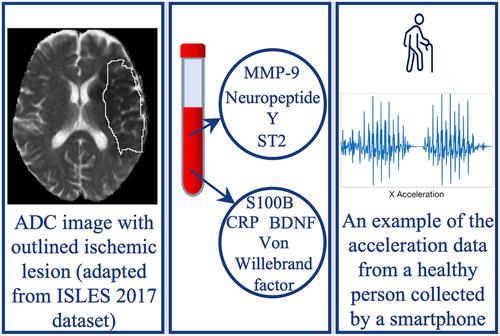当前位置:
X-MOL 学术
›
Eur. J. Nerosci.
›
论文详情
Our official English website, www.x-mol.net, welcomes your feedback! (Note: you will need to create a separate account there.)
Biochemical, biomechanical and imaging biomarkers of ischemic stroke: Time for integrative thinking
European Journal of Neroscience ( IF 3.4 ) Pub Date : 2024-01-14 , DOI: 10.1111/ejn.16245 Meryem Şahin Erdoğan 1 , Esra Sümer Arpak 1 , Cemre Su Kaya Keles 1, 2 , Federico Villagra 3 , Esin Öztürk Işık 1 , Nazire Afşar 4 , Can A. Yucesoy 1 , Luis A. J. Mur 3 , Otar Akanyeti 5 , Hale Saybaşılı 1
European Journal of Neroscience ( IF 3.4 ) Pub Date : 2024-01-14 , DOI: 10.1111/ejn.16245 Meryem Şahin Erdoğan 1 , Esra Sümer Arpak 1 , Cemre Su Kaya Keles 1, 2 , Federico Villagra 3 , Esin Öztürk Işık 1 , Nazire Afşar 4 , Can A. Yucesoy 1 , Luis A. J. Mur 3 , Otar Akanyeti 5 , Hale Saybaşılı 1
Affiliation

|
Stroke is one of the leading causes of adult disability affecting millions of people worldwide. Post-stroke cognitive and motor impairments diminish quality of life and functional independence. There is an increased risk of having a second stroke and developing secondary conditions with long-term social and economic impacts. With increasing number of stroke incidents, shortage of medical professionals and limited budgets, health services are struggling to provide a care that can break the vicious cycle of stroke. Effective post-stroke recovery hinges on holistic, integrative and personalized care starting from improved diagnosis and treatment in clinics to continuous rehabilitation and support in the community. To improve stroke care pathways, there have been growing efforts in discovering biomarkers that can provide valuable insights into the neural, physiological and biomechanical consequences of stroke and how patients respond to new interventions. In this review paper, we aim to summarize recent biomarker discovery research focusing on three modalities (brain imaging, blood sampling and gait assessments), look at some established and forthcoming biomarkers, and discuss their usefulness and complementarity within the context of comprehensive stroke care. We also emphasize the importance of biomarker guided personalized interventions to enhance stroke treatment and post-stroke recovery.
中文翻译:

缺血性中风的生化、生物力学和影像生物标志物:是时候进行综合思考了
中风是影响全世界数百万人的成人残疾的主要原因之一。中风后认知和运动障碍会降低生活质量和功能独立性。第二次中风和出现继发性疾病并产生长期社会和经济影响的风险增加。随着中风事件数量不断增加、医疗专业人员短缺和预算有限,卫生服务机构正在努力提供可以打破中风恶性循环的护理。有效的中风后康复取决于全面、综合和个性化的护理,从改善诊所的诊断和治疗到社区的持续康复和支持。为了改善中风护理途径,人们越来越努力地发现生物标志物,这些生物标志物可以为中风的神经、生理和生物力学后果以及患者对新干预措施的反应提供有价值的见解。在这篇综述论文中,我们旨在总结最近的生物标志物发现研究,重点关注三种模式(脑成像、血液采样和步态评估),研究一些已建立和即将出现的生物标志物,并讨论它们在综合中风护理背景下的有用性和互补性。我们还强调生物标志物引导的个性化干预对于加强中风治疗和中风后恢复的重要性。
更新日期:2024-01-14
中文翻译:

缺血性中风的生化、生物力学和影像生物标志物:是时候进行综合思考了
中风是影响全世界数百万人的成人残疾的主要原因之一。中风后认知和运动障碍会降低生活质量和功能独立性。第二次中风和出现继发性疾病并产生长期社会和经济影响的风险增加。随着中风事件数量不断增加、医疗专业人员短缺和预算有限,卫生服务机构正在努力提供可以打破中风恶性循环的护理。有效的中风后康复取决于全面、综合和个性化的护理,从改善诊所的诊断和治疗到社区的持续康复和支持。为了改善中风护理途径,人们越来越努力地发现生物标志物,这些生物标志物可以为中风的神经、生理和生物力学后果以及患者对新干预措施的反应提供有价值的见解。在这篇综述论文中,我们旨在总结最近的生物标志物发现研究,重点关注三种模式(脑成像、血液采样和步态评估),研究一些已建立和即将出现的生物标志物,并讨论它们在综合中风护理背景下的有用性和互补性。我们还强调生物标志物引导的个性化干预对于加强中风治疗和中风后恢复的重要性。



























 京公网安备 11010802027423号
京公网安备 11010802027423号